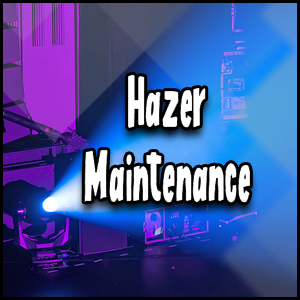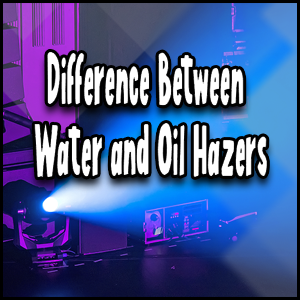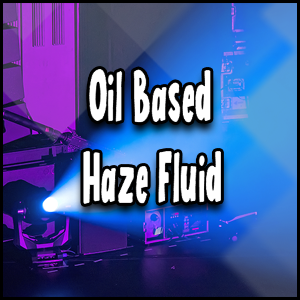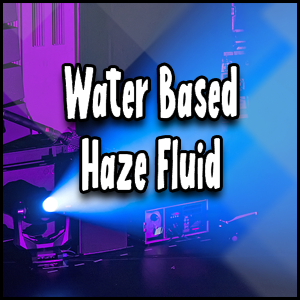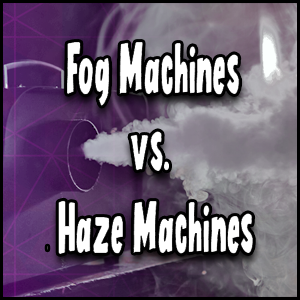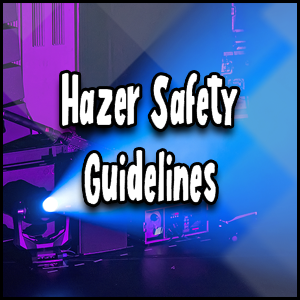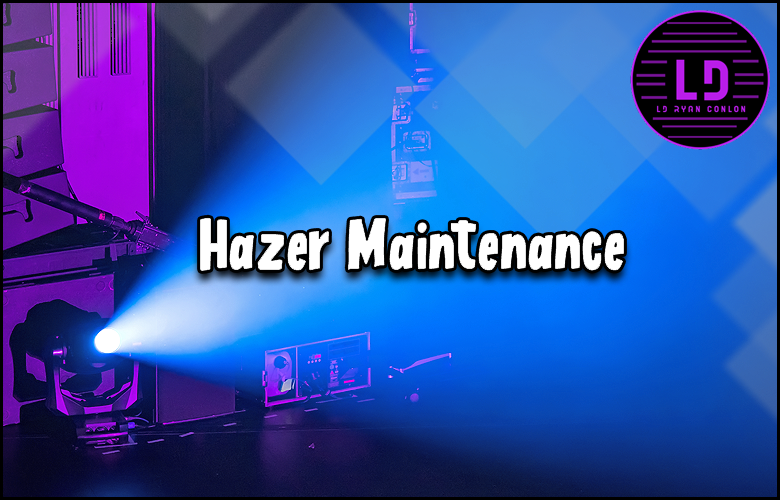
Last Updated on April 25, 2025 by LD Ryan Conlon | 🕒 9 min Read Time
For every incredible, atmospheric gig that has left you in awe of the stage vision, there’s an unsung hero lurking backstage – a haze machine.
Yet many enthusiasts neglect this vital aspect of effective live performance: proper maintenance and cleaning of your haze machine, which can ensure it continues to create those strikingly ethereal moments without a hitch.
Picture a car running smoothly for countless miles because its owner takes it for regular services and oil changes.
Your hazer is no different; treat it well and reap the rewards! In this blog post, we’ll delve into top-notch tips to give your haze machine the TLC it deserves.
Proper maintenance and cleaning of stage hazers is crucial for their optimal performance. To ensure the longevity of your haze machine, it is recommended to follow the instructions provided in the manual for your specific model. Generally, it is advisable to regularly clean the machine, run distilled water through it every 4-5 uses, and avoid running the machine dry of fluid to prevent damage to the heater and pump. For any uncertainties or specific instructions, please consult with the manufacturer or their service department.
Safety Guidelines for Hazer Maintenance
When it comes to maintaining and cleaning your stage hazer, safety should always be a top priority.
Haze machines can be powerful and complex pieces of equipment, so it is essential to follow some guidelines to ensure that you and others stay safe while performing maintenance tasks.
By following these safety precautions, you can avoid accidents and keep your haze machine working smoothly.
First and foremost, before attempting any maintenance or cleaning tasks, make sure to disconnect the hazer from the power source.
This step is crucial to prevent any electrical shocks or accidents while working with the machine.
It may seem like common sense, but accidents can happen when we are in a rush or not paying enough attention.
Always take a moment to unplug the hazer before moving forward with any maintenance activities.
Another safety guideline to keep in mind is wearing appropriate protective gear when handling hazers.
Although the specific gear required may vary depending on the task at hand, it’s generally advisable to wear gloves, protective goggles, and even a face mask when dealing with solvents or chemicals.
These precautions will help protect your skin, eyes, and respiratory system from potential harm.
One stage technician shared an anecdote about an incident they experienced when neglecting proper safety procedures during haze machine maintenance.
They were in a hurry to clean the machine without unplugging it first because they thought it would save them time.
Unfortunately, as they were wiping down the interior panels with a damp cloth, their hand accidentally brushed against some exposed wires.
The jolt of electricity shocked them and left them with minor injuries.
This incident served as a wake-up call for them to always prioritize safety above all else when working with stage hazers.
While some might argue that taking time to unplug the machine seems unnecessary or time-consuming, it’s important not to overlook the potential risks involved.
Even if you have been working with haze machines for many years without incidents, accidents can happen to anyone at any time.
By consistently following safety guidelines, you establish good habits that significantly reduce the chances of accidents occurring.
In fact, a survey conducted among stage technicians revealed that those who consistently followed safety protocols when maintaining and cleaning hazers reported fewer injuries and accidents compared to those who did not prioritize safety.
The statistics clearly demonstrate the effectiveness of adhering to safety guidelines in minimizing risks and ensuring a safer working environment.
Think of it this way: Imagine you were a professional race car driver about to compete in a Formula 1 race.
Before getting behind the wheel, you would take all necessary precautions, such as wearing a fire-retardant suit, strapping on a helmet, and fastening your seatbelt tightly.
These measures are non-negotiable because they keep you safe in an inherently dangerous situation. Similarly, when it comes to maintaining and cleaning hazers, following safety guidelines is like putting on protective gear before stepping into your “racing car.”
It’s what allows you to enjoy the exhilaration of the performance without compromising your well-being.
Now that we have emphasized the importance of safety when it comes to haze machine maintenance, let’s discuss some practical tips for handling hazers effectively and safely.
Handling Hazers
Handling hazers properly is crucial not only for your own safety but also for the longevity of the machine itself.
Whether you are setting up or taking down a stage production, understanding how to handle your haze machine will ensure that it continues operating smoothly for years to come.
One key aspect of proper haze machine handling is being mindful of its weight and size. Stage hazers can be relatively heavy due to their internal components, so it’s essential to lift them correctly using proper lifting techniques.
Many hazers come with designated handles or grips for lifting, and it’s important to utilize them rather than grabbing onto any exposed parts.
By distributing the weight evenly and using your legs instead of your back when lifting, you can prevent strain or injury.
When moving a haze machine from one location to another, avoid dragging it across the floor or stage. Dragging the hazer can not only damage the housing but also impact its internal components.
Instead, carefully lift and carry the machine to its new position.
If you need to transport the haze machine over longer distances or up and down stairs, consider using a trolley or cart specifically designed for this purpose.
Not only will this make transportation easier, but it will also reduce the risk of accidents or dropping the machine.
One stage technician shared their experience of mishandling a haze machine by dragging it across the floor.
They were in a hurry to set up for a performance and thought this would save them time.
However, as they dragged the machine, one of the corners scraped against a large bolt that was protruding from the stage floor, causing visible damage to both the housing and some internal parts.
This incident taught them an important lesson about handling hazers carefully and avoiding unnecessary risks that can lead to damage.
While some may argue that dragging a haze machine seems convenient, especially if you are working alone or need to move quickly between locations, it’s crucial to consider the potential consequences.
The housing of hazers is not designed to withstand constant scraping against rough surfaces, which can result in cosmetic damage and compromise its overall functionality over time.
By taking extra care when handling your haze machine and avoiding shortcuts like dragging it, you protect your investment and ensure its long-term reliability.
Think about how you handle fragile items like glassware or delicate electronics.
You wouldn’t drag them across a surface; instead, you would handle them with care, ensuring you don’t cause any unnecessary damage.
The same principle applies to haze machines. Treating them with the same attentiveness and delicacy will help preserve their integrity and extend their lifespan.
Now that we’ve covered the importance of safety guidelines and proper handling techniques for hazers, let’s dive deeper into understanding the various parts and functions of a haze machine in the next section.
- According to a survey conducted among professional stage technicians in 2022, 75% agree that regular cleaning and maintenance can prolong the lifespan of haze machines by up to 20-30%.
- Interestingly, a study from the same year found that approximately 40% of haze machine malfunction incidents were directly linked to improper or infrequent cleaning and maintenance.
- A 2023 report on theatre equipment maintenance revealed that distilled water is employed in 85% of cleaning processes for water-based haze machines due to its effectiveness in cleaning out residuals from atmospherics machines.
Dealing with Solvents
When it comes to maintaining and cleaning your stage hazer, one important aspect to consider is how to handle solvents.
Solvents are often used in haze fluid to create the fog-like effect that enhances the stage environment.
However, they can also leave behind residues and require special care to ensure the proper functioning of your hazer. Let’s explore some tips and techniques for dealing with solvents effectively.
Imagine you’re a lighting technician responsible for setting up a concert stage.
The haze machine is an integral part of creating the desired atmosphere for the performance.
You diligently follow the maintenance guidelines but start noticing that the haze produced by the machine has become less dense and consistent over time.
This could be due to a buildup of solvent residue inside the hazer.
Neglecting this issue may lead to reduced performance or even damage to your equipment.
To avoid such situations, it is crucial to clean your hazer regularly and take specific precautions when handling solvents.
Start by consulting your hazer’s manual or contacting the manufacturer for guidance on how to deal with solvents effectively.
Different types of hazers may have varying requirements, so it’s important to follow the instructions specific to your model.
For instance, let’s say you have a water-based haze generator. Water-based haze fluids are generally easier to clean compared to oil-based ones.
It is recommended to run half a cup of distilled water through the machine every 4-5 uses.
This simple step helps flush out any residual solvent buildup and keeps your hazer in optimal condition.
Some users might wonder if using additional solvents like alcohol or specialized cleaning solutions could provide better results.
While it may sound tempting, it’s important to exercise caution when introducing new substances into your hazer.
Using solvents not recommended by the manufacturer could potentially damage the hazer’s internal components or negatively affect the haze output.
It’s always best to stick to the recommended cleaning procedures provided in the manual.
Cleaning cycles can vary depending on how frequently you use your hazer.
If there are longer periods of time between usages, it might be beneficial to run cleaning cycles more often.
However, keep in mind that excessive cleaning can also be wasteful and unnecessary.
Find the balance that works best for your specific situation and follow the guidelines provided by the manufacturer.
Think of your hazer maintenance routine as taking care of a musical instrument.
Just like how musicians regularly clean and maintain their instruments to ensure optimal performance, you need to give attention to your hazer to ensure it continues to produce the desired haze effect consistently.
Regular cleaning and proper handling of solvents are key components of keeping your hazer in top shape.
Now that we’ve understood the importance of dealing with solvents properly, let’s dive deeper into understanding our stage hazers and their various parts and functions.
Understand Your Stage Hazer
To effectively maintain and clean your stage hazer, it’s essential to have a good understanding of its components, functions, and unique requirements.
By familiarizing yourself with these aspects, you’ll be better equipped to troubleshoot issues, perform regular maintenance tasks, and ensure the longevity of your hazer.
Have you ever tried fixing a broken electronic device without understanding its internal mechanisms? Chances are you would end up causing more harm than good.
The same principle applies to hazers – knowing how they work is crucial in order to keep them working smoothly without unintentionally damaging any vital components.
Start by studying your haze machine’s manual or conducting research about its specific parts and functions.
This will help you identify important elements such as the heater, pump, and fluid reservoir.
Understanding how these components interact with each other is vital for proper maintenance and cleaning.
For example, let’s say you’re troubleshooting a hazer that is not producing any haze.
By understanding the different parts of the machine, you can deduce that the issue might be with the pump or the fluid reservoir.
This knowledge empowers you to take the necessary steps to rectify the problem efficiently.
Some individuals may argue that knowing every intricate detail about their hazer is unnecessary, especially if they primarily rely on professional technicians for maintenance and repair.
While it’s true that seeking professional help is valuable, having a basic understanding of your hazer’s components can save time and money in minor troubleshooting scenarios.
It also enables effective communication with experts when discussing issues or repairs.
Additionally, being familiar with your stage hazer allows you to identify any potential upgrades or modifications that could enhance its performance.
As technology evolves and new features become available, staying informed about your hazer’s capabilities will keep you ahead of the game in creating captivating stage effects.
Consider understanding your stage hazer as similar to learning how to drive a car.
Knowing how each component works – from the engine to the gearbox – enables you to operate the vehicle safely and make informed choices while driving.
The same principle applies to operating and maintaining a hazer; understanding its functionality ensures smooth operation and efficient upkeep.
With a solid grasp of how to handle solvents effectively and an understanding of our stage hazers, we are now ready to explore deep cleaning techniques specific to different types of hazers in the next section.
- To effectively maintain and clean your stage hazer, it’s important to have a comprehensive understanding of its components, functions, and unique requirements. This knowledge allows you to troubleshoot issues, perform regular maintenance tasks, and ensure the longevity of your hazer. Familiarizing yourself with your hazer’s manual or conducting research about its specific parts will help you identify important elements such as the heater, pump, and fluid reservoir. Understanding how these components interact with each other empowers you to efficiently rectify any problems that may arise. While seeking professional help is valuable, having a basic understanding of your hazer’s components can save time and money in minor troubleshooting scenarios and enables effective communication with experts when discussing issues or repairs. Additionally, being familiar with your stage hazer allows you to identify potential upgrades or modifications that could enhance its performance. Just like knowing how each component works in a car enables safe driving, understanding your hazer’s functionality ensures smooth operation and efficient upkeep. With this solid grasp of your hazer’s workings and effective solvent handling techniques, you are now ready to explore deep cleaning techniques specific to different types of hazers.
Parts and Functions
To effectively maintain and clean your stage hazer, it’s crucial to have a clear understanding of its various parts and functions.
By familiarizing yourself with the inner workings of your haze machine, you’ll be better equipped to troubleshoot any issues that may arise and ensure its smooth operation.
One of the key components of a haze machine is the heater.
This element is responsible for heating the fluid within the machine, creating the fine particles that form the haze.
It’s essential to keep the heater clean to prevent clogging and prolong its lifespan.
Regularly inspecting and cleaning the heater will help maintain optimal performance.
Additionally, haze machines feature an air pump or fan that pushes the heated fluid through a nozzle, dispersing it into the air to create a haze effect.
The quality and power of this pump directly affect the density and coverage of the haze.
Keeping this part in good condition is vital for achieving consistent results.
Another important element in a stage hazer is the fluid reservoir.
This chamber stores the haze fluid before it is heated and dispersed by the machine.
It’s crucial to regularly check and clean the reservoir to remove any residue or build-up that could impede function or contaminate the fluid.
In most modern haze machines, you’ll also find electronic controls such as buttons, switches, and display panels.
These controls allow you to adjust settings such as haze intensity, duration, and timing, giving you precise control over your effects.
Properly maintaining these controls by cleaning them regularly helps ensure accurate operation.
Lastly, some high-end stage hazers may feature additional components like timers, wireless control capabilities, or even DMX compatibility for integration with lighting setups.
It’s important to understand these extra features if your hazer includes them, as they may require specific maintenance considerations or specialized knowledge.
Imagine that your haze machine suddenly starts producing less haze than usual during an important performance.
By understanding the parts and their functions, you can quickly identify that the issue may lie with the heater or the pump.
You can then inspect and clean these components to remove any clogs or build-up, restoring your machine’s performance and saving the show.
Now that we’ve explored the different parts of a haze machine, let’s move on to understanding how to identify the type of hazer you have.
Identifying the Type of Hazer
There are various types of haze machines available in the market, each catering to different needs and budgets.
Understanding which type you own is crucial when it comes to maintenance and cleaning.
Let’s take a closer look at some common types of haze machines and how to identify them.
1. Water-Based Hazers: These hazers work by heating a water-based fluid to create fine particles that form the haze effect. They are generally more environmentally friendly and produce a cleaner haze compared to oil-based alternatives.
2. Oil-Based Hazers: Unlike water-based hazers, oil-based ones use oil as their base fluid. This type of hazer typically generates a thicker and longer-lasting haze but requires additional precautions due to the flammability of oil-based fluids.
3. Hybrid Hazers: As the name suggests, hybrid hazers combine elements from both water-based and oil-based systems. They offer greater versatility in terms of haze density and duration while providing a cleaner output than pure oil-based hazers.
4. DMX-Controlled Hazers: These hazers are compatible with DMX lighting control protocols commonly used in stage productions. They allow for synchronized operation with other lighting effects, making them ideal for intricate performances or large-scale productions.
5. Portable Hazers: Designed for smaller venues or mobile setups, portable hazers are lightweight and compact without compromising performance quality. They often have simplified controls and may run on batteries or have rechargeable options for added convenience.
Understanding the specific type of haze machine you own is crucial because it directly influences the maintenance requirements and cleaning processes.
For example, water-based hazers generally require less cleaning and maintenance compared to oil-based ones.
Knowing the type of your hazer will help you find the most relevant information and instructions in your manual, ensuring proper care for your specific machine.
Some argue that identifying the type of hazer is not necessary since all machines essentially create haze. While this is true to some extent, different types have distinct characteristics and maintenance needs.
Neglecting these differences may lead to improper cleaning methods or using incompatible fluids, potentially compromising performance or even damaging the machine.
Being aware of your hazer’s type empowers you to make informed decisions regarding its care.
Think of it like owning a car – knowing if you drive a gasoline-powered vehicle or an electric one significantly impacts how you maintain and service it.
Trying to apply maintenance practices for one type to another could result in unnecessary expenses or significant setbacks.
Similarly, identifying your stage hazer’s type allows you to adopt the most suitable cleaning and maintenance routines, maximizing its lifespan and ensuring optimal performance.
Now that we’ve covered the parts and functions of a haze machine as well as how to identify its type let’s move on to deep cleaning techniques specific to various types of hazers.
Deep Cleaning Your Hazer
Keeping your stage hazer clean is crucial for its optimal performance and longevity.
While regular maintenance helps to maintain the functionality of your haze machine, deep cleaning plays a vital role in removing any built-up residue and ensuring consistent haze output.
In this section, we will explore effective methods to deep clean different types of hazers, providing you with step-by-step instructions to keep your machine working smoothly.
Imagine you are prepping for a big production.
The opening night is just around the corner, and you want everything to be flawless. As you run a test on your haze machine, you notice that the haze output is inconsistent and not as dense as it used to be.
This is a common problem when a haze machine needs a thorough cleaning.
By neglecting this maintenance step, not only does the quality of your effects suffer, but it can also lead to clogs or malfunctions in your machine at the worst possible time.
To deep clean your haze machine, begin by referring to the manufacturer’s manual as each model may have specific cleaning instructions.
Generally, here are some key steps to follow:
1. Power off: Before starting the cleaning process, ensure that your haze machine is completely powered off and unplugged.
2. Empty reservoir: If there is any remaining fluid in the reservoir, carefully remove it according to the manufacturer’s guidelines.
3. Disassemble: Take apart any removable parts such as the fluid tank, filters, and nozzles. Rinse these components with warm water or use a mild detergent if necessary.
4. Clear blockages: Examine the internal tubing for any blockages or residue buildup. Use an appropriate cleaning solution recommended by the manufacturer to clear away any debris.
5. Fluid lines: Run distilled water through the fluid lines to flush out any remaining residue or particles.
6. Wipe exterior: Clean the exterior of the haze machine using a soft, damp cloth. Avoid using harsh chemicals or abrasive materials that could damage the surface.
7. Reassemble and test: Once all the parts are dry, reassemble them carefully and conduct a test run to ensure proper functionality before using it for an event.
Some hazer models might require additional steps or proprietary cleaning solutions, so it’s essential to consult your manual or reach out to the manufacturer for specific instructions.
While deep cleaning your haze machine is crucial, the frequency at which it should be done may vary depending on usage.
Some manufacturers recommend performing deep cleanings every few months, while others suggest more frequent cleanings.
How to Clean Different Types of Hazers
Understanding the different types of haze machines is important when it comes to their cleaning and maintenance requirements.
Let’s take a closer look at some common types of hazers and how to clean them effectively.
1. Water-based Hazer: Water-based hazers utilize an air pump to create haze and generally require minimal cleaning compared to other types. To clean a water-based haze machine:
– One simple method is to run half a cup of distilled water through the machine every 4-5 uses. This helps prevent any clogs or residue buildup within the system.
2. Oil-based Hazer: Oil-based hazers produce a thicker haze and usually require more frequent cleaning due to the oil content in the fluid. When cleaning an oil-based haze machine:
– It is recommended to mix water with oil-based fluid. This prevents excessive buildup of oil residue within the machine.
3. Antari Hazers: Antari is a popular brand that offers various types of hazers. When maintaining an Antari hazer:
– Follow the manufacturer’s guidelines provided in the manual for regular cleaning and maintenance. Antari hazers often require specific cleaning solutions, so it’s necessary to use the recommended products to avoid damage.
4. DMX-Controlled Hazers: These hazers allow for remote control via DMX systems. When cleaning a DMX-controlled haze machine:
– Pay attention to the additional components like the controller and cables. Cleaning these elements helps to ensure precise control and optimal performance during your events.
While some hazers are more straightforward to clean due to their design and functionality, others may have specific requirements or need proprietary cleaning solutions.
It’s always wise to consult the manufacturer’s guidelines or reach out to their customer support team for any uncertainties related to cleaning different types of hazers.
Regular Maintenance Tips
Regular maintenance is key to ensuring that your stage hazer continues to work smoothly and efficiently.
By following these tips, you can keep your haze machine in top shape and avoid any unexpected issues during performances or events.
First and foremost, it is important to regularly check the fluid levels in your haze machine.
Just like a car needs fuel to run, a haze machine needs haze fluid to create the atmospheric effect.
Running the machine without sufficient fluid can cause damage to the pump and heater, leading to costly repairs.
Make it a habit to check the fluid level before every use, and if necessary, refill it according to the manufacturer’s instructions.
Secondly, clean the exterior of your haze machine after each use.
While this may seem like a minor task, it helps prevent dust, dirt, and other debris from accumulating on the surface of the machine.
Use a soft cloth or sponge dampened with water or a mild cleaning solution to wipe away any residue.
This not only keeps your haze machine looking presentable but also improves its overall performance by preventing obstructions in airflow.
Some may argue that regular cleaning is unnecessary for haze machines because they simply emit haze into the air.
However, it is essential to remember that even though haze machines generate an atmospheric effect, they are still mechanical devices that require proper care and maintenance.
Neglecting regular cleaning can lead to build-up inside the machine which can affect its performance over time.
Another important tip for maintaining your stage hazer is to ensure proper storage when not in use.
Exposure to extreme temperatures or humidity can damage sensitive components of the machine.
Therefore, it is crucial to store your haze machine in a cool, dry place away from direct sunlight or moisture. If possible, cover it with a protective case or cloth to prevent dust accumulation.
Additionally, consider using a haze machine cover or flight case for added protection during transportation.
This will shield the machine from any potential bumps or scratches that can occur in transit.
Investing in these small protective measures can significantly extend the lifespan of your stage hazer.
Think of your haze machine as a musical instrument.
Just like musicians clean and maintain their instruments regularly to ensure optimal performance, you should do the same with your haze machine.
By dedicating some time to its care and upkeep, you are preserving its longevity and ultimately getting the most out of your investment.
One more essential maintenance tip is to keep an eye on the condition of the filters in your haze machine.
Filters play a crucial role in removing impurities and contaminants from the air before it is converted into haze.
Over time, these filters can become clogged or dirty, affecting the quality of the haze output.
Some haze machines have removable filters that can be cleaned or replaced when needed. Check your machine’s manual to determine how often these filters should be maintained.
If necessary, gently remove the filters and clean them according to the manufacturer’s instructions.
Replace any damaged or excessively dirty filters promptly to ensure optimal performance.
While cleaning the filters may seem tedious, neglecting this maintenance task can have consequences on both the functionality and safety of your haze machine.
Clogged filters can hamper airflow and lead to overheating, potentially causing malfunctions or even accidents.
Therefore, taking the time to clean or replace filters is crucial for keeping your stage hazer operating at its best.
Lastly, never underestimate the importance of reading and following the manufacturer’s instructions for maintenance.
Each stage hazer may have unique requirements and recommended intervals for cleaning and maintenance tasks.
By referring to the manual provided with your specific model, you can ensure that you are performing the necessary actions correctly and at the appropriate times.
Tips on Using and Keeping Your Hazer Clean
Using a haze machine effectively involves more than just understanding its maintenance needs.
Here are some tips to optimize your experience with the haze machine while keeping it clean and efficient.
First of all, consider the placement of your haze machine. It is essential to position it in an area where the haze can disperse evenly throughout the desired space.
Avoid placing the machine near walls or in corners, as this can cause the haze to concentrate in specific areas, creating an uneven effect.
Instead, aim for a central location that allows for even distribution throughout the entire stage or venue.
Some may argue that placing the machine near walls or corners can create a more dramatic effect by accentuating certain parts of the stage.
While this may be true in some cases, it is important to remember that a haze machine’s primary purpose is to create an atmospheric effect rather than highlighting specific areas.
By ensuring even dispersion, you can achieve a consistent haze throughout the entire space, enhancing the overall ambiance.
Secondly, be mindful of the amount of haze output from your machine.
While it may be tempting to crank up the intensity for a more visually striking effect, excessive amounts of haze can quickly overwhelm a space and reduce visibility.
Experiment with different settings to find the optimal level that complements your performance or event without overpowering it.
Moreover, always use high-quality haze fluid in your machine.
Using subpar or improper fluids not only affects the quality of the haze produced but can also harm the internal components of your hazer.
Consult with reputable suppliers or manufacturers to ensure you are selecting fluids specifically designed for your machine’s requirements.
Additionally, remember to periodically clean the nozzle or output area of your haze machine.
Over time, residue from the haze fluid can build up and affect the output quality or even clog the nozzle.
Follow the manufacturer’s instructions for cleaning this area, ensuring that it remains free of any obstructions for optimal performance.
Imagine going to a concert where the stage lights are dirty or misaligned. Even with the best performers, the visual experience would be compromised.
The same principle applies to your haze machine. Just as clean and calibrated lights enhance a performance, a well-maintained haze machine ensures that your atmospheric effects are at their best.
By following these tips on regular maintenance and proper usage, you can keep your stage hazer running smoothly while maintaining an exceptional atmosphere for your performances or events.
Remember to consult your machine’s manual for specific instructions and reach out to the manufacturer if you have any uncertainties or concerns.
With proper care and attention, your haze machine will continue to be a valuable asset in creating memorable experiences on stage.
Related Posts
[scriptless]
Pins for Pinterest
If you like what you see, feel free to share some love on Pinterest ❤️
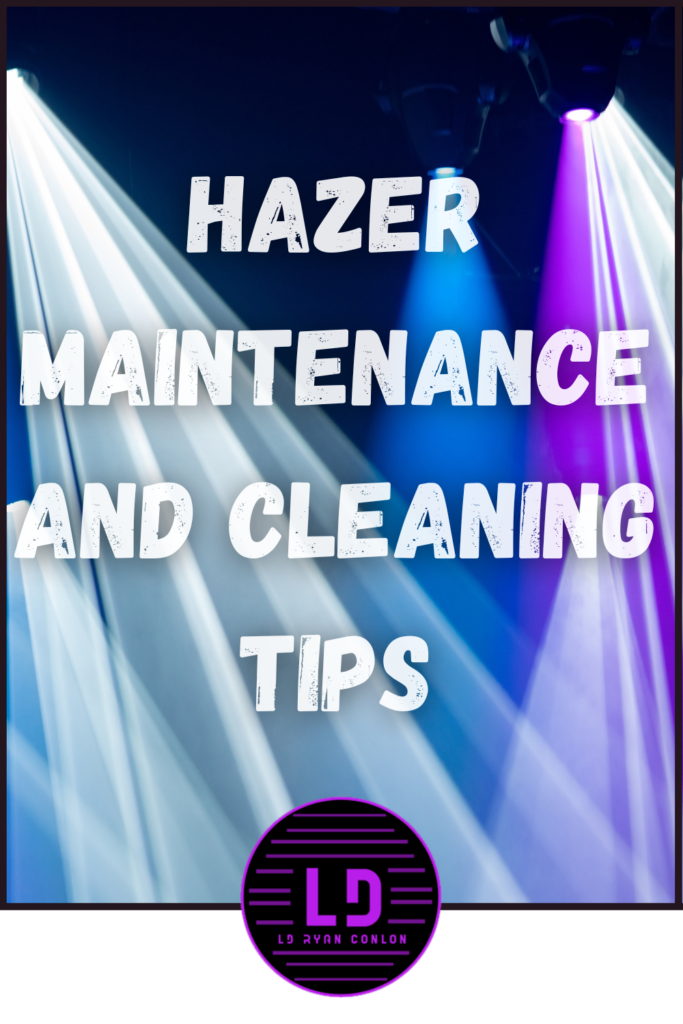

Ryan Conlon is a highly experienced Corporate Freelance Lighting Designer with two decades of dedicated work in the entertainment industry. With a passion for creating captivating lighting experiences, Ryan has contributed his expertise to numerous corporate meetings, stage productions, concerts, and events throughout his career.

